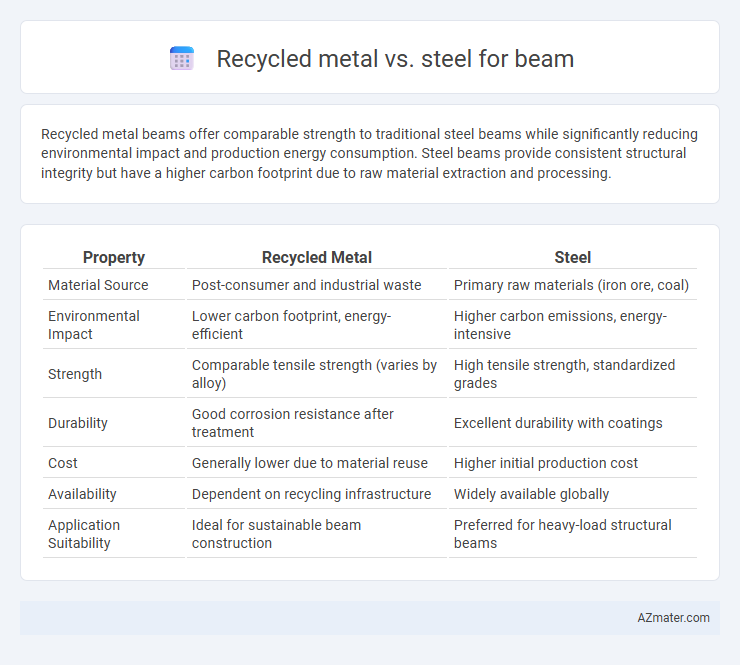Recycled metal beams offer comparable strength to traditional steel beams while significantly reducing environmental impact and production energy consumption. Steel beams provide consistent structural integrity but have a higher carbon footprint due to raw material extraction and processing.
Table of Comparison
| Property | Recycled Metal | Steel |
|---|---|---|
| Material Source | Post-consumer and industrial waste | Primary raw materials (iron ore, coal) |
| Environmental Impact | Lower carbon footprint, energy-efficient | Higher carbon emissions, energy-intensive |
| Strength | Comparable tensile strength (varies by alloy) | High tensile strength, standardized grades |
| Durability | Good corrosion resistance after treatment | Excellent durability with coatings |
| Cost | Generally lower due to material reuse | Higher initial production cost |
| Availability | Dependent on recycling infrastructure | Widely available globally |
| Application Suitability | Ideal for sustainable beam construction | Preferred for heavy-load structural beams |
Introduction to Recycled Metal and Steel Beams
Recycled metal beams are fabricated from salvaged scrap metals, reducing environmental impact and conserving natural resources, while maintaining structural integrity for various construction applications. Steel beams, commonly made from virgin raw materials, offer high strength, durability, and versatility, making them a standard choice in building frameworks. Both recycled metal and steel beams provide essential load-bearing support but differ in their sourcing, sustainability, and cost-effectiveness.
Material Composition and Sourcing
Recycled metal beams primarily contain a mix of scrap steel and other alloying elements, retaining durability while reducing environmental impact through reclaimed raw materials. Steel beams, typically made from virgin iron ore with precise alloy composition, offer consistent strength and uniformity crucial for structural applications. Sourcing recycled metal reduces dependency on mining and lowers carbon emissions, whereas virgin steel requires energy-intensive extraction and refining processes.
Environmental Impact Comparison
Recycled metal beams significantly reduce environmental impact by lowering energy consumption and greenhouse gas emissions compared to newly produced steel beams. The process of recycling metal cuts down mining waste and conserves natural resources, contributing to decreased ecological degradation. Steel beams, while durable, demand high energy input during extraction and manufacturing, intensifying carbon footprints and resource depletion.
Structural Strength and Performance
Recycled metal beams maintain comparable structural strength and performance to traditional steel beams, offering a sustainable alternative without compromising load-bearing capacity or durability. The process of melting and reforming recycled metal preserves its tensile strength, making it suitable for high-stress construction applications. Compared to virgin steel, recycled metal beams often have equivalent resistance to corrosion and fatigue, ensuring long-term reliability in structural frameworks.
Cost Efficiency Analysis
Recycled metal beams offer significant cost savings compared to new steel, with material expenses often reduced by 20-40% due to lower production costs and decreased energy consumption. Steel beams, while generally more consistent in quality and structural performance, tend to incur higher initial costs related to raw material extraction and manufacturing. Evaluating long-term expenses, recycled metal can also reduce waste disposal fees and environmental compliance costs, enhancing overall cost efficiency in construction projects.
Durability and Longevity
Recycled metal beams, often composed of scrap steel, retain comparable durability and longevity to traditional steel beams due to rigorous processing and quality standards. Steel beams, known for their high tensile strength and resistance to corrosion when treated, provide exceptional long-term structural support in construction. Both materials offer sustainable options, but recycled steel beams can reduce environmental impact without compromising lifespan or performance.
Installation and Workability
Recycled metal beams offer significant advantages in installation due to their lighter weight and ease of handling compared to traditional steel beams, reducing labor time and costs. Steel beams provide superior workability with precise fabrication options and compatibility with various welding and bolting techniques, ensuring strong structural connections. Choosing recycled metal can improve sustainability without compromising installation efficiency, while steel ensures consistent performance in complex structural applications.
Industry Standards and Certifications
Recycled metal beams must meet stringent industry standards such as ASTM A36 and ISO 14001 certification, ensuring structural integrity and environmental compliance. Steel beams typically conform to standards like ASTM A992, known for high strength and durability in construction applications. Both recycled metal and steel beams require certifications from authorized bodies like the American Institute of Steel Construction (AISC) to guarantee safety, performance, and sustainability in building projects.
Applications in Construction Projects
Recycled metal beams are increasingly favored in sustainable construction projects due to their reduced environmental impact and comparable structural strength to traditional steel beams. Steel beams, however, remain the preferred choice for high-load applications such as commercial skyscrapers and large industrial facilities due to their consistent quality and load-bearing capacity. Both materials offer excellent durability, but recycled metal beams provide cost savings and lower carbon footprints, making them ideal for eco-conscious residential and mid-rise construction projects.
Future Trends in Sustainable Beam Materials
Recycled metal beams are gaining traction in construction due to their lower carbon footprint and reduced energy consumption compared to traditional steel beams. Advances in sorting and alloying technologies enable recycled metals to match or exceed the performance standards of virgin steel, promoting circular economy principles in sustainable building practices. Future trends indicate a growing preference for hybrid beams that combine recycled metals with high-strength steel to optimize durability and environmental impact.

Infographic: Recycled metal vs Steel for Beam
 azmater.com
azmater.com